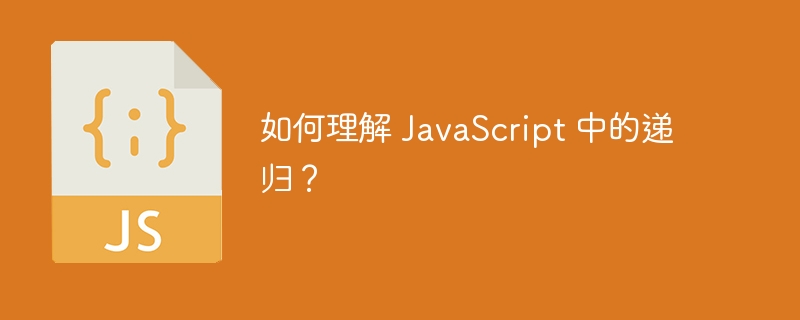如何理解 JavaScript 中的递归?

什么是递归?
递归一词来自recurring,意思是一次又一次地回到过去。递归函数是通过一步步改变输入来一次又一次调用自身的函数。这里,将输入改变一级意味着将输入减少或增加一级。
每当递归函数达到基本条件时,它就会停止自身的执行。让我们通过一个例子来理解什么是基本条件。例如,我们需要求一个数的阶乘。我们通过将输入减 1 来调用阶乘函数,并且每当输入达到 1 时就需要停止。因此,这里 1 作为基本条件。
语法
用户可以使用下面的语法来理解 JavaScript 中的递归。
function recur(val) {
if (base condition) {
return;
}
// perform some action
// decrease the value of val by one step
return recur(newVal);
}
在上面的语法中,用户可以观察到当基本条件变为 true 时我们返回 null 以停止函数的执行。如果基本条件为 false,我们将使用输入值执行某些操作,并使用新的参数值再次调用 recur() 函数。
现在,让我们看一下递归的各种示例。在这里,我们将学习首先使用 for 循环实现迭代算法,然后将其转换为递归方法。
示例 1(使用 for 循环求 1 到 n 个数字的和)
在下面的示例中,我们编写了 sumOfN() 函数来获取 1 到 N 个数字的总和。我们使用 for 循环进行了 N 次迭代,并且在每次迭代中,我们将 I 的值添加到 sum 变量中。
最后返回sum变量的值。
<html>
<body>
<h3>Using the <i> iterative approach </i> to find sum of n numbers in JavaScript</h3>
<div id = "content"> </div>
<script>
let content = document.getElementById('content');
// function to find the sum of n numbers using an iterative approach
function sumOfN(n) {
let sum = 0;
for (let i = n; i >= 1; i--) {
sum += i;
}
return sum;
}
content.innerHTML += "The sum of 1 to 10 numbers is " + sumOfN(10) + "<br>";
content.innerHTML += "The sum of 1 to 20 numbers is " + sumOfN(20) + "<br>";
</script>
</body>
</html>
在上面的示例中,我们使用迭代方法来求 N 个数字的总和。现在,我们将使用递归方法来做同样的事情。
示例 2(使用递归函数求 1 到 n 个数字的和)
sumOfN() 函数是下面示例中的递归函数。我们通过将参数的值减 1 来重复调用 sumOfN() 函数。 sumOfN(N1) 返回 N-1 个数字的总和,我们将 N 添加到它以获得 N 个数字的总和。每当 N 的值变为 1 时,它就会返回 1,这作为停止函数执行的基本条件。
<html>
<body>
<h3>Using the <i> recursive approach </i> to find sum of n numbers in JavaScript</h3>
<div id = "content"> </div>
<script>
let content = document.getElementById('content');
// function to find the sum of n numbers using a recursive approach
function sumOfN(n) {
// base condition
if (n == 1) {
return 1;
}
// call function recursively by decreasing the value of n by 1.
return n + sumOfN(n - 1);
}
content.innerHTML += "The sum of 1 to 10 numbers is " + sumOfN(10) + "<br>";
content.innerHTML += "The sum of 1 to 20 numbers is " + sumOfN(20) + "<br>";
</script>
</body>
</html>
让我们了解一下上面的递归函数是如何工作的。下面,用户可以逐步了解递归函数调用是如何发生的。
sumOfN(5);
return 5 + sumOfN(4);
return 4 + sumOfN(3);
return 3 + sumOfN(2);
return 2 + sumOfN(1);
return 1;
return 2 + 1;
return 3 + 3;
return 4 + 6;
示例 3(合并数组所有字符串的迭代方法)
在下面的示例中,我们创建了字符串数组。我们创建了 mergeString() 函数来将数组的所有字符串合并为一个字符串。我们使用 for 循环遍历数组,并将所有字符串一一合并到“str”变量中。
<html>
<body>
<h3>Using the <i> iterative approach </i> to merge all strings of the array in JavaScript</h3>
<div id = "content"> </div>
<script>
let content = document.getElementById('content');
// function to merge all strings of the array using for loop
function mergeString(arr) {
let str = '';
for (let i = 0; i < arr.length; i++) {
str += arr[i];
}
return str;
}
let arr = ['I', ' ', 'am', ' ', 'a', ' ', 'programmer'];
content.innerHTML += "The original array is: " + arr + "<br>";
content.innerHTML += "After merging all strings of the array into the single string is " + mergeString(arr) + "<br>";
</script>
</body>
</html>
示例 4(合并数组所有字符串的递归方法)
在下面的示例中,我们已将 mergeString() 函数转换为递归函数。我们获取数组的第一个元素,并将其与 mergeString() 函数的返回结果合并。 mergeString() 函数返回合并后的最后 n-1 个数组元素。此外,我们使用 slice() 方法从数组中删除第一个元素。
当数组中只剩下一个元素时,它返回相同的元素,该元素作为基本条件。
<html>
<body>
<h3>Using the <i> Recursive approach </i> to merge all strings of the array in JavaScript</h3>
<div id = "content"> </div>
<script>
let content = document.getElementById('content');
// function to merge all strings of the array using recursion
function mergeString(arr) {
// based condition
if (arr.length == 1) {
return arr[0];
}
// remove the first element from the array using the slice() method.
return arr[0] + " " + mergeString(arr.slice(1));
}
let arr = ["I", "am", "a", "web", "developer"];
content.innerHTML += "The original array is: " + arr + "<br>";
content.innerHTML += "After merging all strings of the array into the single string is " + mergeString(arr) + "<br>";
</script>
</body>
</html>
用户应该使用哪种方法,迭代还是递归?
主要问题是哪种方法更好,迭代还是递归,以及用户应该使用哪种方法。
在某些情况下,迭代方法比递归方法更快。此外,递归在迭代过程中需要更多的内存。对于某些算法(例如分治法),递归更有用,因为我们需要使用递归方法编写更少的代码。此外,如果递归方法中未触发基本条件,用户可能会面临内存泄漏问题。
如果我们可以将代码分解成更小的部分,我们应该使用递归方法,而为了提高代码的性能,我们应该使用迭代方法。
以上是如何理解 JavaScript 中的递归?的详细内容。更多信息请关注PHP中文网其他相关文章!

热AI工具

Undresser.AI Undress
人工智能驱动的应用程序,用于创建逼真的裸体照片

AI Clothes Remover
用于从照片中去除衣服的在线人工智能工具。

Undress AI Tool
免费脱衣服图片

Clothoff.io
AI脱衣机

AI Hentai Generator
免费生成ai无尽的。

热门文章

热工具

记事本++7.3.1
好用且免费的代码编辑器

SublimeText3汉化版
中文版,非常好用

禅工作室 13.0.1
功能强大的PHP集成开发环境

Dreamweaver CS6
视觉化网页开发工具

SublimeText3 Mac版
神级代码编辑软件(SublimeText3)

热门话题
 如何在浏览器中优化JavaScript代码以进行性能?
Mar 18, 2025 pm 03:14 PM
如何在浏览器中优化JavaScript代码以进行性能?
Mar 18, 2025 pm 03:14 PM
本文讨论了在浏览器中优化JavaScript性能的策略,重点是减少执行时间并最大程度地减少对页面负载速度的影响。
 如何使用浏览器开发人员工具有效调试JavaScript代码?
Mar 18, 2025 pm 03:16 PM
如何使用浏览器开发人员工具有效调试JavaScript代码?
Mar 18, 2025 pm 03:16 PM
本文讨论了使用浏览器开发人员工具的有效JavaScript调试,专注于设置断点,使用控制台和分析性能。
 谁得到更多的Python或JavaScript?
Apr 04, 2025 am 12:09 AM
谁得到更多的Python或JavaScript?
Apr 04, 2025 am 12:09 AM
Python和JavaScript开发者的薪资没有绝对的高低,具体取决于技能和行业需求。1.Python在数据科学和机器学习领域可能薪资更高。2.JavaScript在前端和全栈开发中需求大,薪资也可观。3.影响因素包括经验、地理位置、公司规模和特定技能。
 如何使用源地图调试缩小JavaScript代码?
Mar 18, 2025 pm 03:17 PM
如何使用源地图调试缩小JavaScript代码?
Mar 18, 2025 pm 03:17 PM
本文说明了如何使用源地图通过将其映射回原始代码来调试JAVASCRIPT。它讨论了启用源地图,设置断点以及使用Chrome DevTools和WebPack之类的工具。
 console.log输出结果差异:两次调用为何不同?
Apr 04, 2025 pm 05:12 PM
console.log输出结果差异:两次调用为何不同?
Apr 04, 2025 pm 05:12 PM
深入探讨console.log输出差异的根源本文将分析一段代码中console.log函数输出结果的差异,并解释其背后的原因。�...
 初学者的打字稿,第2部分:基本数据类型
Mar 19, 2025 am 09:10 AM
初学者的打字稿,第2部分:基本数据类型
Mar 19, 2025 am 09:10 AM
掌握了入门级TypeScript教程后,您应该能够在支持TypeScript的IDE中编写自己的代码,并将其编译成JavaScript。本教程将深入探讨TypeScript中各种数据类型。 JavaScript拥有七种数据类型:Null、Undefined、Boolean、Number、String、Symbol(ES6引入)和Object。TypeScript在此基础上定义了更多类型,本教程将详细介绍所有这些类型。 Null数据类型 与JavaScript一样,TypeScript中的null








